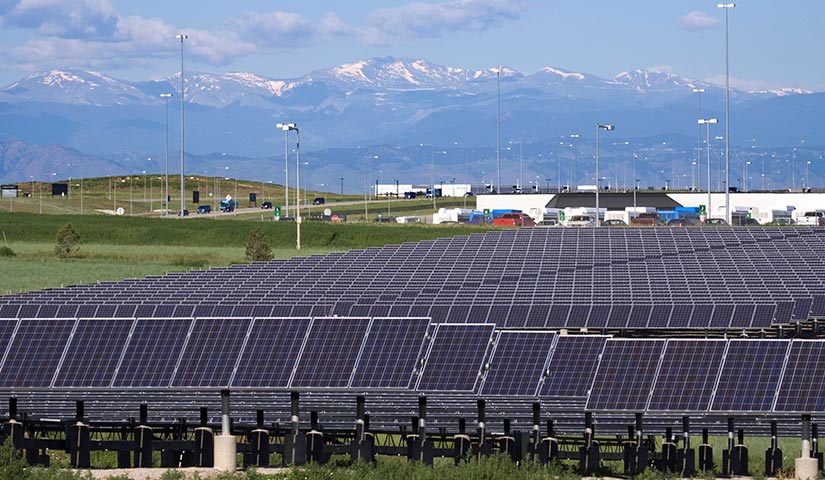Federal Aviation Administration Partners With NREL for a Holistic Look at Energy Needs of Electrified Aircraft
NREL's Analysis of Electric Charging Infrastructure Will Prepare Airports To Welcome Sustainable Aircraft While Boosting Grid Resilience and Connecting Communities

The first federal office on aviation was established in 1926, a pivotal age for opening air commerce, travel, and technology. Within a year, Charles Lindbergh completed his history-making transatlantic flight from the United States to France. Crowds of onlookers jammed Le Bourget Field, near Paris, to glimpse the airplane and pilot that had flown 3,610 miles to their shores. Only 24 years had passed since the Wright brothers flew a mere 120 feet at Kitty Hawk.
Read NREL's technical report on Electrification of Aircraft: Challenges, Barriers, and Potential Impacts (Schwab, Amy, et al., Oct 2021).
Aviation has undergone several periods of rapid innovation in the last hundred years, and an emerging trend in electrified aircraft is pushing the industry to its next frontier. As new models of aircraft come online, the federal government continues to play a critical role in certifying airworthiness and promoting safety in the skies and on the ground. This is now the responsibility of the U.S. Department of Transportation's Federal Aviation Administration (FAA).
With integrated analysis from the National Renewable Energy Laboratory (NREL), the FAA can create safety standards and recommend efficient and resilient airport infrastructure able to support these advanced aircraft designs.
NREL's Holistic Planning Integrates Aircraft and Airports
NREL will assess a selection of U.S. airports to determine solutions for implementing electrical infrastructure at scale, with a focus on energy efficiency, cost savings, and resilience.
"We asked, who is evaluating the infrastructure for electrified flight?" said Scott Cary, NREL's lead for various sustainable aviation initiatives. "We are now digging into that component so the FAA can provide the guidance airports need if they choose to be an early adopter."
Multiple electric aircraft are currently in certification, with targeted markets of cargo, passenger, and special purpose needs over short distances. Many take off and land without a runway, like helicopters, and some are preparing for pilotless operation.
The FAA will provide safety guidance for the planning and design of landing areas and on-the-ground infrastructure to support these aircraft at public facilities. Historically, most airport electrical systems were not built to support megawatt-level charging, and energy for facilities is managed independently of energy for the aircraft.
"The Federal Aviation Administration is researching the infrastructure needs of these unique aircraft," said FAA airport research specialist Wesley Major. "NREL's analysis of airport infrastructure is a critical component in this strategy."
Aside from charging services and safety, the study will measure associated factors such as the growth potential for jobs supporting the advanced air mobility, particularly in underserved areas, and the reduction in greenhouse gas emissions. This comprehensive understanding will enable ambitious energy-saving goals and illuminate pathways to transition legacy systems to support next-generation aviation.
Stabilizing the Grid With Local Generation
Airport location is determined by transportation needs, not energy supply. Many aviation hubs, particularly in rural areas, are located at the end of the distribution lines where power supply is already limited.
"The question is, if you bring a new energy load into a community, can you bring in a source of generation with it?" Cary said. "Smaller airports may receive two scheduled flights per day. That aircraft could recharge using on-site generation or generation on adjacent land leased to an energy provider, and for the remainder of the day those resources are making the local grid more stable. It establishes energy closer to where people are using it and connects communities."
NREL's analysis uses data from real airports and generic specifications of aircraft currently in certification. Site assessments will identify recommended locations for charging and scenarios for providing energy, including integrating various mixes of energy storage and generation. The FAA recently updated guidance on siting solar photovoltaics and battery energy storage and streamlined the review process for airports. According to a 2020 study from the University of Colorado, 20% of public airports in the United States had adopted solar PV technology.
Airport infrastructure on the ground currently accounts for 9%–20% of total emissions from aviation. This could be greatly reduced using ecosystem-wide adaptations. Diversifying energy sources, along with innovative fuels (including those derived from renewable sources), could lead to more consistent power supply for the airport and the communities it serves.
NREL's research team is also performing a hazard analysis to help the FAA set standards for energy security and resilience. The robust analysis anticipates the likelihood and effects of disruptions such as lightning, a power surge, water or debris, cord damage, and many other possible events, and the mitigation measures that limit the risk and impact. A high-level cybersecurity assessment will inventory possible cyber-related risks and draw on NREL's past research in the cybersecurity of extreme fast-charging stations for electric cars and trucks.
"Leveraging the U.S. Department of Energy's laboratory system supplements the FAA's programs and capabilities," Major said. "Working with NREL allows the FAA to leverage existing transportation research to aerospace needs."
Balancing loads and generation, considering stakeholder perspectives, and performing techno-economic analysis with site-specific complexities is characteristic of NREL's energy systems integration capabilities. The laboratory has spent more than 20 years supporting the electric, hydrogen, and biofuels industries on the ground—now it is time to take it into the sky.
Learn more about NREL's research capabilities for sustainable aviation.
Last Updated May 28, 2025
